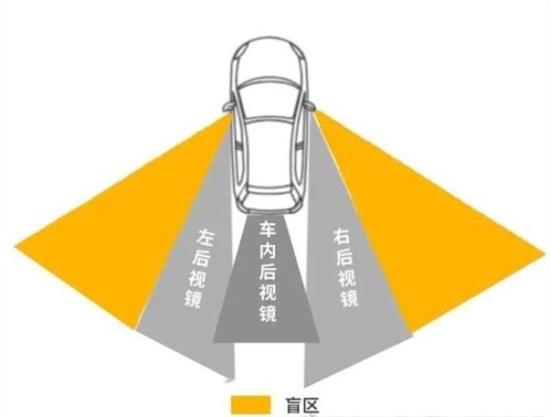Learn how to deal with the "driving blind spot" this stealth bomb, for all drivers is a must learn skill, driving blind zone refers to the area we can not see when driving, to put it comprehensively and rigorously, that is, we are located in the normal driving seat, the line of sight is obscured by the car body and can not be directly observed the part of the area.
Driver friends should have a deep understanding of the blind spot of the car, when we start, turn, change lanes, reverse the car will cause different directions of the blind spot.
What are the driving blind spots?
1. A-column blind area
This is a common car blind spot during driving, often formed when the car turns or merges, A pillar will block part of the driver's line of sight, which may make the driver unable to find obstacles on the road or pedestrians in time, and its potential danger is very easy to lead to traffic accidents.

For example, when waiting for a red light, especially when the light is about to change, it may suddenly "flash" the traveler, and he wants to run over a few seconds later, thinking that you will give way. Actually, you may not have seen him at all.
2. Front/rear blind zone
Affected by the front engine compartment, rear trunk, and driver's height, after sitting in the driver's seat, a large blind area of vision will be formed in front of and behind the vehicle. It is difficult to spot low children or obstacles that appear in front of and behind the vehicle.
We have seen on the Internet that many children squatting down to play by the side of the car and being crushed are mostly caused by the driver not observing the situation in front of and behind the car in advance.
3. Rearview mirror blind area
The blind spot of the rearview mirror, also known as the blind area of lane change, refers to the area behind the car, on the side, beyond the reflection range of the rearview mirror, which mostly occurs when changing lanes and turning.
Current rearview mirrors are generally reflectors, not wide-angle lenses. When steering or changing lanes, if the angle is too large, the left and right rearview mirrors may not be able to see the incoming car in the target lane. In addition, if too many items are stacked in front of the rear windshield, it will also affect the rearview mirrors in the car, forming a blind spot.
4. Inner wheel difference blind zone
The inner wheel difference refers to the difference between the turning radius of the front inner wheel and the turning radius of the rear inner wheel when the vehicle is turning. Under normal circumstances, a large car will produce an inner wheel difference of 2 meters, and a small car will produce an inner wheel difference of 1 meter.
When turning, if there are people and things close to the body, it is very easy to cause a shi. Especially for large trucks, the blind spot of the inner wheel difference is a large blind spot, which can be said to be a "death zone".
How to circumvent? Scratch the point!
1. Be particularly vigilant and pay attention when turning, and observe the pedestrians and driving conditions in front of you in advance. Then slow down the speed of the car, and move your body back and forth to see the situation left and right of the car, to ensure that the situation in the blind area of the field of vision is clear, so that it is a safe way to pass.
2. Before getting on and reversing, you should go around the car for a week and pay attention to whether there are foreign objects at the bottom of the vehicle. In addition, it is also possible to check with the help of the 360° panorama function.
3. Adjust the angle of the mirror after getting on the car. The left rearview mirror should be adjusted to the two rear handles where the body can be seen; when the right rearview mirror is adjusted, the focus should be on the low-middle line of sight; and the rearview mirror in the car should be adjusted so that the main driver can clearly observe the entire contents of the rear window.
4. When making a sharp turn, if you are the driver, slow down to make sure that there are no pedestrians and then turn; if you are a pedestrian, you should stand at a safe distance of 2 meters away. Otherwise, even if the front wheels can get you over, the rear half of the car will hit you.
5, driving on the mountain road, be sure to pay attention to the roadside traffic signs, remember to observe the convex mirror at the turn, encounter the car can be timely honking reminder, and timely adjustment of the driving state.
6, when driving at night, the old drivers not only have to withstand the change of light, but also to deal with the stimulation of the headlights of the car on the opposite side, and the vision is further limited. Therefore, when entering and exiting the tunnel, drivers must adapt to the change of light as soon as possible and maintain a safe distance from the car in front.
Dear drivers, in daily driving, in fact, most of the above blind spots appear when turning and affect driving safety. Therefore, before getting on the car, you should remember to check around the car for a week, and when driving, you should remember to slow down and steer safely. Driving vision blind spot is not terrible, master the right way to break through the blind spot of vision, travel outside, safety first yi.